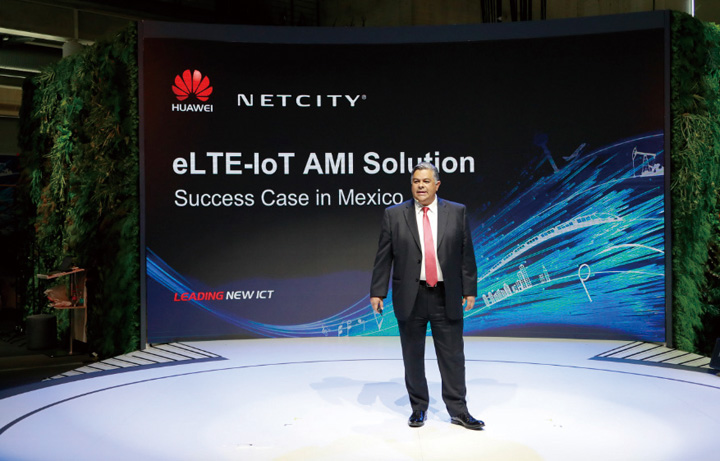eLTE-IoT Network for Mexican Power Grid
Produits, solutions et services pour les entreprises
Akıllı Telefonlar, Bilgisayar&Tabletler, Giyilebilirler ve Daha Fazlası

With the convergence and development of Information and Communications Technology (ICT), bits do more than simply measure volumes of data. Instead, the benefits of digital transformation are generating beneficial reactions and good partnerships across industries industry. In the new era of Mexico’s electric power industry, the transition means that ‘bits drive watts.’
Smart meters have fundamentally changed the electric power business. In Latin America, one of the world’s largest regional electric power markets, digital transformation is predicted to unleash an opportunity that will equal USD 24 billion (MXN 495.1 billion) in value.
According to the 2013 to 2017 national power system plan, Mexico’s infrastructure investment will reach USD 97.1 billion (MXN 2 trillion) in the next 15 years. The largest power company of Mexico provides integrated management services for power generation, transmission, transformation, distribution, and use, wanted to upgrade power grid.
Mexico implemented a new electricity law in 2014 that opened the national power grid to investment to promote competition for the generation and sales of electrical power. The openness and competition in the electric power sales market have led to a common demand by electric power sales for neutral, third-party metering — which is used especially by large industrial and commercial users. NetCity, owned by GOES, has emerged against this backdrop to help electric power sales enterprises improve operations capabilities and solve problems such as difficult and slow fee collection, high line loss, poor management, and low customer satisfaction. The Advanced Metering Infrastructure (AMI) solution provides electric power organizations with a smart metering platform based on bi-directional high-speed communication that allows real-time transaction charges. Huawei’s comprehensive user management system effectively prevents electricity theft, analyzes line-loss statistics, and streamlines operations. The end-to-end deployment of AMI solutions is the first step toward solving the many endemic problems occurring through their service lifecycle.
Because of the difficult and time-consuming of network build and capacity expansion, the power grid company facilitated additional support through a partnership with NetCity — a professional wireless Internet of Things (IoT) provider to efficiently and cost-effectively collect electricity consumption data from homes and businesses, reduce line losses and fee collection times, and increase revenue.
The digital communications network is the nervous system for the AMI platform. Huawei will use an enterprise Long-Term Evolution-Internet of Things (eLTE-IoT) network as the backbone for the AMI system. The open system is designed for ease of integration for partners collaborating to provide secure and cost-effective End-to-End (E2E) smart grid solutions.
The eLTE-IoT network operates in the 902 MHz to 928 MHz Industrial, Scientific, and Medical (ISM) frequency band, uses 3GPP 4.5G technology, and employs new features that comply with the laws and regulations for unlicensed spectrum, enabling backhaul communication for power metering, for improved security, reliability, and network performance that exceed published IoT requirements for AMI.
• Improved reliability: The Huawei eLTE-IoT network has adopted a two-level, anti-interference retransmission technology that applies Forward Error Correction (FEC) and narrowband Frequency Hopping (FH) to ensure stable connections over the ISM radio spectrum.
• Strong security protection: Bi-directional authentication prevents abnormal intrusions and E2E encryption ensures service security for signaling data.
• Wider coverage: Multi-hop technology improves indoor coverage that, when combined with high terminal receiver sensitivity, ensures network access to underground layers.
• Additional connections: Slotted ALOHA technology doubles spectral efficiency and improves the granularity of resource allocation for concurrent channel transmission that enables 3,000 AMI devices to be read from a single base station.
• Reduced power consumption: Power Saving Mode (PSM) and Extended Discontinuous Reception (eDRX) technologies are used to extend the battery life for devices in the field for up to 10 years.
• Open system: Huawei eLTE-IoT components share an industry chain and development ecosystem with Narrow-band-IoT (NB-IoT) products. This fact allows Huawei to develop collaborations with global partners through the OpenLabs facilities located around the world. Following a thorough and in-depth due diligence review, the Huawei eLTE-IoT solutions were selected for use by the Mexican electric power industry.
In the first quarter of 2017, the technical specifications of the Huawei’s eLTE-IoT platform were written into the Mexican National Industrial Communications Act, and in the second quarter of 2017, eLTE-IoT-connected AMI meters passed the admission certification and earned Huawei the contract for a Phase 1 deployment.
The Huawei OpenLab center in Mexico is a development and cooperation environment for ecosystem partners that has also played an important role in Mexican electric power project. The OpenLab facility provided a setting for the joint incubation and verification of AMI devices — with the goal to enhance product competitiveness in the Latin American market. The testing completed in the OpenLab forms has helped partners to pass the admission certification requirements published by Mexico’s CFE Equipment and Materials Testing Laboratory (Laboratorio de Pruebas de Equiposy Materiales, or LAPEM).
The Huawei eLTE-IoT solution also passed the tests conducted by Mexico’s Federal Institute of Telecommunications (Instituto Federal de Telecomunicaciones, or IFT). During the IFT test regime, Huawei identified over 290 interconnection requirements in the solution development field — plus an additional 16 optimization requirements for partners — resulting in an 80 percent performance improvement for AMI meter-reading.
The Huawei eLTE-IoT communications platform was first deployed in Mexico City in the fourth quarter of 2017. With a population of over 21 million people, and the location for nearly half of the country’s industrial, commercial service, and financial institutions, Mexico City was chosen to address the most urgent needs to for electrical power system reconstruction and AMI deployment.
Following site construction, Huawei conducted a wide range of fixed-point and mobile tests in multiple settings, including densely populated urban areas, commercial districts, highways, and outdoor open areas, to accurately evaluate the typical, real-world coverage for eLTE-IoT-connected AirNodes.
The network was deployed with AMI smart meters integrated with eLTE-IoT modules and General Packet Radio Service/IoT (GPRS/IoT) dual-mode electrical meters, which allowed the meters to access the GPRS public network, and send back data in areas without IoT coverage. After the IoT network coverage was improved, services could be smoothly migrated to the new wireless IoT private network, reducing public network leasing, hardware, and servicing costs associated with electrical meter replacement.
According to the test results, the eLTE-IoT delivered a 4 km coverage radius in densely populated urban areas, and an 8 km coverage radius in outdoor areas having no obstacles. The reported success rate for AMI smart meters integrated with eLTE-IoT communication modules exceeded 99 percent.
AMI smart meters are just the first step in Mexico’s electric power transformation, and NetCity’s wireless eLTE-IoT network is enabling local electric power companies to process AMI services and build a unified platform to that will allow an increasing number of Smart City services — such as smart water and smart street lamps — to create a powerful nervous system for Smart City solutions in Mexico.
Ricardo Villasana, CTO of GOES Telecom, said, “Huawei’s eLTE is a robust and comprehensive solution that offers us an IoT platform with a high price-performance ratio. This solution has optimized the metering in aspects such as timeliness, security, and O&M expenses. Looking ahead to the future, we are expecting this solution to bring seamless coverage to Mexico City, one of the largest cities in the world. The main advantage of deploying NetCity’s own network is to target not only the electric metering market, but also Water and Gas. Additionally, we are deploying value-added solution in other verticals, such as: Smart Parking, Street Lighting, Remote Environmental Monitoring, e-Farming, etc.”

【Customer Testimony】
“Huawei’s eLTE is a robust and comprehensive solution that offers us an IoT platform with a high price-performance ratio. This solution has optimized the metering in aspects such as timeliness, security, and O&M expenses. Looking ahead to the future, we are expecting this solution to bring seamless coverage to Mexico City, one of the largest cities in the world.”
— Ricardo Villasana, CTO, GOES Telecom